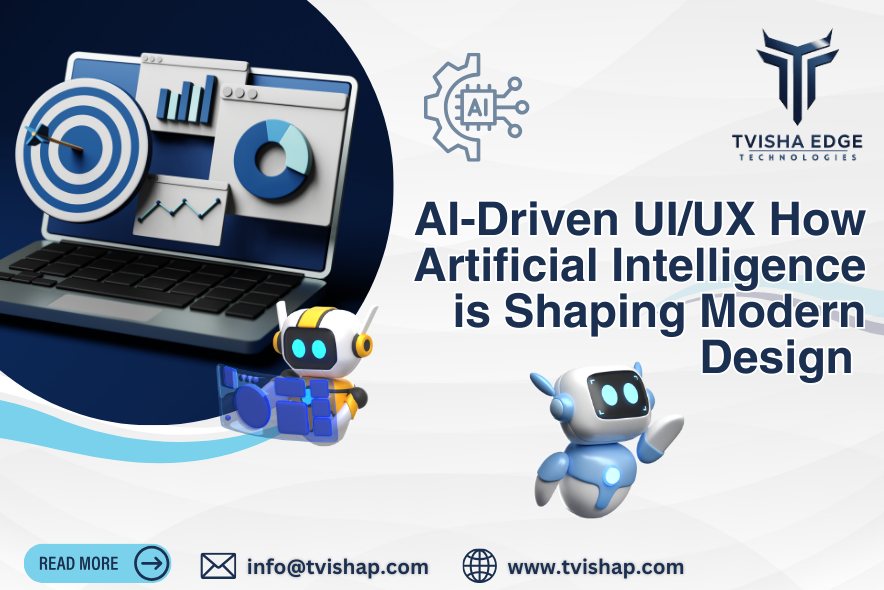At Tvisha Edge Technologies, we have always embrace Innovative, particularly artificial intelligence (AI), to revolutionize UI/UX design.
AI-driven design is no longer a futuristic concept—it’s a reality that’s transforming the way designers approach user interfaces. From personalized experiences to predictive design elements, AI is setting new standards in usability, accessibility, and aesthetics.
How AI is Transforming UI/UX Design
1. AI-Powered Personalization
Personalization is key to enhancing user engagement, and AI makes it more efficient than ever. Traditional UI/UX designs rely on static elements, but AI-powered solutions dynamically adjust interfaces based on user behavior, preferences, and interactions.
- Recommendation Systems: Platforms like Netflix and Amazon leverage AI-driven algorithms to suggest content tailored to users’ preferences.
- Adaptive UI: AI modifies UI components based on real-time interactions, ensuring a more intuitive experience for users.
- Chatbots and Virtual Assistants: AI-driven assistants like Siri, Alexa, and ChatGPT enhance user interactions through intelligent conversational interfaces.
2. Predictive User Behavior Analysis
AI analyzes vast amounts of user data to predict future behaviors and interactions. By leveraging machine learning algorithms, businesses can optimize UI elements for maximum engagement.
- AI identifies patterns in user interactions to predict what features users will likely use next.
- Heatmaps and AI-driven analytics tools analyze user activity, helping designers refine layouts for improved usability.
- Automated A/B testing enables designers to experiment with multiple versions of UI components and determine the best-performing designs.
3. Automated Design Assistance
Designing UI/UX elements manually is time-consuming, but AI simplifies the process with automation tools. AI-powered platforms assist designers by generating UI components, layouts, and prototypes based on predefined patterns.
- Tools like Adobe Sensei, Uizard, and Figma AI assist designers in creating wireframes, color palettes, and layouts effortlessly.
- AI enhances efficiency by automating repetitive design tasks, such as resizing images and suggesting typography combinations.
- AI-based design systems ensure brand consistency by standardizing UI elements across different platforms.
4. Voice and Conversational UI
Voice-controlled interfaces are becoming increasingly popular, and AI plays a pivotal role in their development. Virtual assistants like Google Assistant, Siri, and Alexa have redefined user interaction, making UI/UX design more intuitive and accessible.
- Natural Language Processing (NLP) enables AI-driven chatbots to understand user intent and provide accurate responses.
- AI enhances accessibility by enabling voice-activated controls for users with disabilities.
- Conversational AI ensures a seamless user experience by allowing customers to interact with applications using voice commands.
5. AI for Accessibility and Inclusive Design
AI is making digital products more accessible to users with disabilities. Designers can leverage AI tools to create inclusive UI/UX experiences that cater to diverse user needs.
- Automated image recognition tools provide alt text descriptions for visually impaired users.
- AI-powered speech-to-text technology enhances accessibility for individuals with hearing impairments.
- AI-driven contrast adjustment and color recognition features optimize readability for users with color blindness.
Benefits of AI-Driven UI/UX Design
- Enhanced User Engagement – AI-driven interfaces adapt in real time, ensuring users receive a personalized and engaging experience.
- Increased Efficiency – Automation speeds up design processes, reducing manual work for designers and developers.
- Improved Accessibility – AI tools ensure that digital platforms are inclusive and accessible to a wider audience.
- Data-Driven Decision Making – AI analyzes user behavior and provides actionable insights to improve design strategies.
- Seamless Interactions – AI-powered chatbots and voice interfaces improve user interactions by offering instant responses.
Challenges in AI-Driven UI/UX Design
While AI enhances UI/UX design, it also presents some challenges:
- Data Privacy Concerns – AI relies on user data for personalization, raising concerns about data security and privacy.
- Over-Personalization Risks – Excessive personalization can feel intrusive, reducing user trust in digital platforms.
- High Implementation Costs – AI-powered design tools require significant investment and expertise.
- Lack of Human Touch – AI-generated designs may lack creativity and emotional intelligence compared to human designers.
- Algorithm Bias – AI models can unintentionally reinforce biases, leading to unfair or discriminatory design outcomes.
Future of AI in UI/UX Design
The integration of AI in UI/UX design is still evolving, but the future looks promising. Emerging trends indicate that AI will continue to shape the digital landscape in several ways:
- Hyper-Personalization: AI will refine user experiences by offering even more precise and context-aware recommendations.
- AI-Generated Design Systems: AI will automate entire design workflows, reducing the need for manual intervention.
- Augmented Reality (AR) & AI Fusion: AR-driven UI/UX experiences will enhance virtual shopping, education, and healthcare applications.
- Ethical AI Design: Designers will focus on creating responsible AI-driven experiences that prioritize user privacy and inclusivity.
Tvisha Edge Technologies is a UI/UX Design in India including locations Andhra Pradesh, Arunachal Pradesh, Assam, Bihar, Chhattisgarh, Goa, Gujarat, Haryana, Himachal Pradesh, Jharkhand, Karnataka, Kerala, Madhya Pradesh, Maharashtra, Manipur, Meghalaya, Mizoram, Nagaland, Odisha, Punjab, Rajasthan, Sikkim, Tamil Nadu, Telangana, Tripura, Uttar Pradesh, Uttarakhand, and West Bengal.
Tvisha Edge Technologies is Best UI/UX Design Company in Singapore Including Locations Jurong East, Kallang, Marina Bay, Pasir Ris, Yishun, Bukit Timah, Central Area, Eastern Singapore, Kampong Glam, Little India, Orchard, Queenstown, Sengkang, Sentosa and Tampines.

